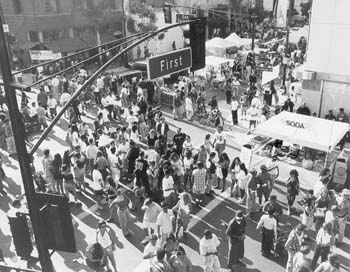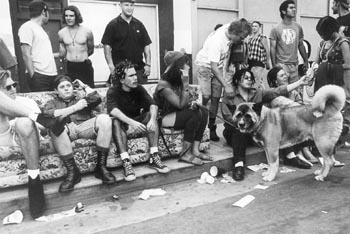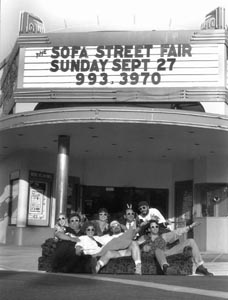![[Metroactive Music]](http://metroactive.com/music/gifs/music468.gif)
[ Music Index | San Jose | Metroactive Central | Archives ]
Reupholstering SoFA
Nine years on, an edgy street fest reinvents itself as a music and technology showcase
BORN AMID a recession, grunge rock and '90s dance club culture, the SoFA street fair was low-tech and tactile--a mosh of beer, guitar rock and sweaty, tattooed bodies aside an idiosyncratic collection of people hawking crafts, fetish leather and fringe politics. Like most everything these days, both the SoFA district and its flagship event are gentrifying, and now the four-day festival is reinventing itself to claim a space in the vortex of the convergence of music and digital technology.
Giving the music festival a distinctly Silicon Valley spin seems an obvious evolution. The festival now incorporates a conference and expo while remaining connected to its alternative roots. Past SoFA fests have featured previously little-known future stars like Cake and Smash Mouth; this year's buzz band is the newly signed Insolence.
"SoFA's always been about what's next," observes Fil Maresca, a festival organizer and co-founder who helped popularize the acronym for South First Area at a time when the city Redevelopment Agency's marketing geniuses were calling it the Market-Gateway Arts and Entertainment District (MGAED).
Maresca says the modest foray into virtual musicology will be among the first digital music fairs to cater to listeners rather than the music or technology industries, giving them the chance to sample new music and weigh in on topics like artists' rights, MP3 and Napster litigation and the music industry paradigm collapse.
Are You Experienced? For its sixth year, Metro's annual charity benefit joins up with the newly revamped SoFA festival.
Day-By-Day Schedule: An overview of festival events.
SoFA Music Experience Schedule: Sunday's street festival lineup.
Local Mavericks: Insolence lives up to its hype and becomes the next big thing from San Jose.
Underground Sound: San Jose's hip-hop culture is showcased at an all-day expo.
Dance Revolutionary: Karl Denson's Tiny Universe brings a party groove to jazz and soul.
FREED FROM THE FILES after nearly a decade, Metro's photos of the first SoFA street fair, in 1992, evoke the quaintness of an unearthed time capsule. Look, there's the piercing tent. Can that really be the F/X players in full regalia performing selections from Hair? How 20th-century.
Only one shot passes muster for the new millennium: a booth urging Republicans to register for Bush. Photoshop out the "92," and the intervening eight years of turmoil and change for the annual San Jose music festival melt away.
Except for the hopeless revanchism of the Republican Party, it's a different time and place. Although some might pine for the slacker-chic of the early-'90s, the rapid morphing of the four-day musical behemoth, newly rebranded the SoFA Music Experience, shouldn't set off any alarm bells. Not here anyway, where even fun-loving rebels can figure out a way to make enough money to support their passions.
The fair began as a freewheeling--and free of charge--Bohemian event modeled after San Francisco's Haight Street Fair. Designed to promote San Jose's SoFA nightclub district, it eventually evolved into a gated, user-friendly festival in the mid-'90s.
Now, for its ninth year, organizers have programmed a four-day event showcasing a lineup of homegrown talent (see sidebars). The new format still encompasses the original Sunday street fair of booths and wacky hawkers (need a hat made out of newspapers?) along with performances by local bands. It also includes a day (Sept. 16) of brain food: conferences and workshops focused on music and technology.
Additionally, the SoFA Music Experience has become the new home for the Metro Foundation's annual charity concert, SFMX6. Perhaps inevitably, given the rise of Napster and the like, a dotcom (ULTRAViBE.com) signed on as a major sponsor.
FESTIVAL ORGANIZERS say that the format changes are in keeping with the area's development as more 9-to-5 businesses spread through the neighborhood. The result: a mélange of upscale "daytime" office spaces and nightlife establishments--and a far cry from neighborhood's reputation as a destination for stroke mags and sex toys little more than a decade a go.
"It's time to evolve again, because the neighborhood keeps evolving" Maresca says. Until 1995, Maresca co-owned F/X The Club, a centerpiece of early SoFA culture. F/X closed in October 1995 and reopened under new ownership as the Usual that December.
"SoFA has not had its share of attention [from the city], which is not necessarily a bad thing," Maresca adds. "We don't look like the rest of downtown and don't want to. A lot of interesting buildings are on top of each other here, and the businesses are mixed. It's much more dynamic than if it was planned. The neighborhood has evolved on its own."
The official neglect of SoFA has had its benefits. Anger over city red tape encountered by Marsugi's nightclub in its 1986 attempt to add an awning led to the founding of the Downtown Association, an organization that played a key role in the city core's cultural and business renaissance. Marsugi's, where Nirvana once played, eventually closed up, as did some of the pioneering nightclubs, lunch spots and retailers. Still, despite the unfortunate conversion of retail and restaurant space to offices, independent cinema, art galleries, a small theater company and a record store remain in the SoFA district's eclectic business mix, and the festival that bears its name has grown bigger than the small district itself.
At first, Maresca says, the festival aimed to serve "as a celebration of the community, exposing SoFA to people who didn't know about it. The festival established the name and the community. It really gave the neighborhood an identity." Now, he figures, "it's time to take on a new role."
Gary Walker, a co-founder of the festival and originator of the term "SoFA," says that there had always been a notion to include some kind of music-oriented--although not necessarily technologically slanted--expo. But Walker remembers that, in part, the festival's quick rise to popularity had somewhat eclipsed the original plans. "The neighborhood was forming so quickly, and the event just took off. We just continued with the festival part."
The new SoFA Music Experience, Walker says, will "incorporate businesses that have always supported the festival." This year, SoFA district vanguards like the Camera Cinemas, d.p. Fong Gallery and the San Jose Institute of Art will provide meeting spaces for the expo and conferences, while another SoFA pioneer, Eulipia, will cater the VIP party.
"If we continued to focus merely on the festival, it would be just another party on First Street," Walker explains. And it seems that local technology finally gave the expo idea the boost it needed.
LONGTIME SoFA ORGANIZER and club promoter Chris Esparza describes SoFA's expansion as a way to broaden the draw of the festival. "It's keeping afoot with presenting the best of the South Bay on a music level, but also with what's happening on the whole Left Coast," Esparza says. "It's maturing into something more unique and more creative," which he hopes will begin to attract more out-of-towners, and maybe, in a few years, visitors from out of state.
Esparza says that most of the conferences were designed to appeal to those involved in different aspects of music, essentially musicians, music industry insiders and consumers, a triad that the make-up of the panels tries to reflect. "Washington, D.C., is not the only player that decides what happens with Napster," says Esparza, in reference to one of this year's four panel discussions, "Metallica is Dirty Rotten Filthy Stinking Rich ... but do they have a point?"
Though Napster has millions of youthful users, in targeting a broader, perhaps more professional audience, the festival's new format does veer away from the fair's originally youth-oriented bent.
In recent years, as crowd numbers swelled, police and city officials became wary of SoFA. Rumblings of gang activity led to the addition of gates and a cover charge in 1996, as well as the moving of all punk and ska music off the street stages and into the clubs. Walker acknowledges that there were "differences of opinion between us and the police department about the nature and safety of the event." But he points out that making the event more controlled has paid off. "After a couple of years, after proving it safe, we get to go back in the other direction and incorporate all kinds of music. We can bring the edginess back."
Getting edgier by getting safer sounds like a paradox. Something of the same dilemma has dogged Burning Man. Once a near revolutionary event, the Dionysian doings in the desert have been reduced to fodder for mainstream media happy to gawk at the naked, sand-covered bodies.
Naturally, the success of SoFA's "new edge" this year will determine its future audience--and its scope. "We don't want South by South West, but we want an element of it," says Esparza. Echoing that sentiment, Walker says, "We hope to make it the Cinequest of music," and hints at bigger and better possibilities for the festival a few years in the future, "Wouldn't this be wonderful if it was a week-long, or a two-week-long, festival of art and music?"
[ San Jose | Metroactive Central | Archives ]
Copyright © 2000 Metro Publishing Inc. Metroactive is affiliated with the Boulevards Network.
For more information about the San Jose/Silicon Valley area, visit sanjose.com.
![]()

A First: A view of an early SoFA Street Fair, taken from atop F/X The Club (now the Usual) shows SoFA's major crossroads at South First and San Salvador streets. Marsugi's (now Agenda) can be seen in the background.
![[line]](/gifs/line.gif)
![[line]](/gifs/line.gif)

Cushion Too Hard: South First music lovers take five on a sidewalk sofa in 1992.
 Brain Trust: The first organizers of SoFA--(from left) Shannon Durham, Dan Defloix, Mimi Paulsen, Pam Kelley, Gary Walker, Richard Ajluni, Michael Sullivan and Fil Maresca--take a well-deserved break under the marquee of F/X The Club (now the Usual).
Brain Trust: The first organizers of SoFA--(from left) Shannon Durham, Dan Defloix, Mimi Paulsen, Pam Kelley, Gary Walker, Richard Ajluni, Michael Sullivan and Fil Maresca--take a well-deserved break under the marquee of F/X The Club (now the Usual).
From the September 14-20, 2000 issue of Metro, Silicon Valley's Weekly Newspaper.